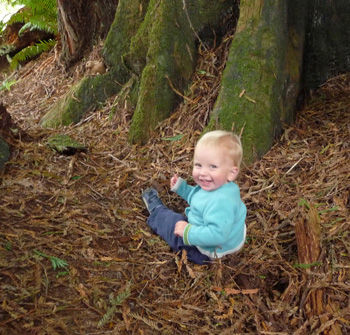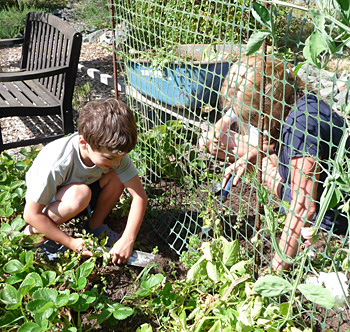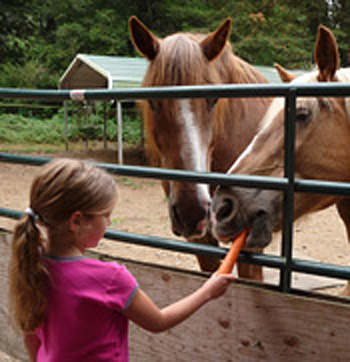PLANTS & ANIMALS
An atmosphere of love and respect for plants and animals, in the home, is the best foundation.
Nothing can substitute for walking in nature, hearing birds, looking for shells on the beach, watching the daily growth of a flower in the garden. From the very beginning of life it is vital to maintain the link between the child and nature.
PLANTS
For the infant we can provide flowers and fruit to explore by sight and smell; show her the shadows of tree leaves and the sound of their rustling in the wind. It is important for a child to spend some time in the outdoors experiencing nature every day if possible—in all kinds of weather and during all of the seasons.
Very early in life a child will appreciate the variety of texture, and color of, tree bark, leaves, flowers, then looking at brightly colored pictures in plant books.
In the first three years of life the child is absorbing, without effort, every experience and the name of everything. Near the end of this period of life she will "explode" into language, using all the words she has been hearing. So from the beginning we can use the exact words, so the child will be able to. Not just flower but California Poppy, and descriptive words such as orange, small, and soft.
If you are a gardener who knows the Latin or scientific names of plants, you will find that these are as easy for the child as the common names and what fun to learn them now.
If you are planning an outdoor environment that will be good for children, be sure to include a space for wild flora and fauna. Some of the best biological specimens are wild plants, such as dandelions and thistles.
When the child begins to walk, there is a lot she can do related to plants. Gather dead leaves from beneath a house plant, dust plant leaves, cut and serve fresh fruit, and so on. Simple flower arranging and leaf washing is enjoyed at this age since the child loves to do anything to do with water, pouring water into a tiny vase and placing one bloom on the table on a cotton doily for the family meal.
Having garden tools and a small wheelbarrow and helping to carry grass cuttings or anything else that needs to be transported is an excellent way to involve the child with the yard work. But even one pot with one plant is better than nothing where there is no garden. A large clay pot can actually serve as a great ever-changing seasonal garden for the family, and is just the right size for the child to participate in the gardening in the early years.
NOTE: Be sure that house and garden plants are safe for children.
Beautiful pictures of plants and flowers, sometimes examples from great works of art, can be hung on the wall; and you may be surprised at a child's preference for nonfiction books about nature when she has been kept in touch in this way.
ANIMALS
Animals are best observed free in nature rather than in cages. Hang a bird feeder just outside the window and show the child how to sit quietly so that the birds won't be afraid.
Binoculars give the child a feeling of participating in the birds' activities, and allow the child to watch birds from a distance. Having temporary tadpole guests, and watching cocoons hatch is a truly magical experience for the child. It provides the experience of seeing a creature close up without having to keep it permanently out of its natural setting.
Because wild animals are less accessible to the children than plants, we suggest observing birds, insects, and other animals in nature, and after this experience, providing more animal models, pictures, and books about them—picture books, beginning reading books, and reference books.
Playing with animal models and blocks has always been a favorite open-ended-toy choice of children. Please be sure that your child's animal models are made of safe plastic instead of toxic plastic materials. We find that the ones made by European companies are safe for children at this age.
We focus on the child's natural love for and affinity with nature, and the tendency to want to touch, hold, and care for nature specimens such as rocks, shells, seeds, flowers and leaves, insects, kittens—all things living and nonliving.
Animal models and books can help the child explore animals outside their immediate surrounding and learn even more names.
Another gift from our children comes to the adult when we slow down, to follow the interests of the child, to learn to be in the moment, appreciating nature that is all around us, taking the time to listen, to taste, to see, to feel, to appreciate.
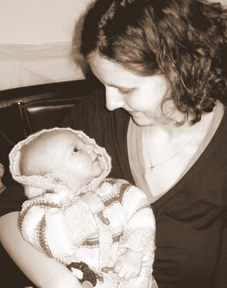
The Montessori birth to three is being translated into several languages and being spread around the world, helping many families. To see the translations so far (Chinese, Polish, Arabic, Russian, and Japanese, and soon Portuguese and Spanish) go to the bottom of this page: translations
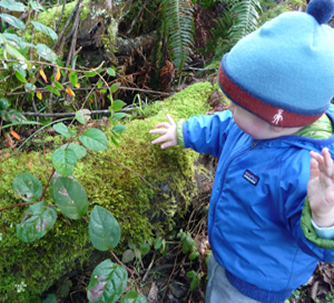
Go to this site for 3 pages of video clips following the developmental stages of the child from birth to three years: videos
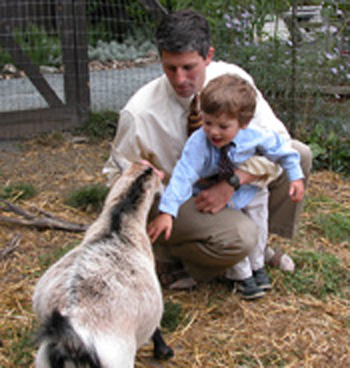
|
PLANTS
Nature Table or Nature Shelf
A little table or shelf, in the home or classroom, dedicated to a changing array of beautiful objects from nature, is a delight to children. Some suggestions are a vase of flowers, leaves, a colored leaf in the fall, or a plant experiment (from the biology curriculum described in detail in the book "The Red Corolla" see below).
It is also the place where the botany experiments, to teach that a plant needs warmth, light, and water, can be carried out. In traditional classes an experiment like growing a seed might be done as a group, with one paper cup and seed for each child. But this kind of experiment always makes some of the children feel bad as their seed doesn't sprout, or introduces competition as one plant is taller than another. In a Montessori class there is just one seed in a cup, or experiment, for all children to share.
It is important to keep this area very clean, beautiful, and constantly changing. A little tray with a magnifying glass could be kept on the nature table for closer observation. In the 3-6 classroom a plastic mat, bucket and sponge; and a small drying towel are kept on a tray under or near the nature table. One of the favorite activities is to carefully clean the table and the items on the table.
Lay out a plastic mat and carefully remove everything from the shelf. If there are dry leaves or soil, show the child how to wipe them off the edge of the table and into his hand. Next show him how to dip and wring out the sponge, and to wipe the top of the table and the legs. With a drying cloth dry everything. Wipe and dry the plastic mat, then clean the sponge, hang the drying cloth up to dry and replace it with a fresh one. And replace the items on the table, letting the child decide on their arrangement. Now the child knows how to carry out this activity at any time, independently of an adult's permission. This gives the child the feeling of really caring for the beautiful objects and not just looking at them.
Plants
It is important for a child to spend some time in the outdoors experiencing nature every day if possible—in all kinds of weather and during all seasons. Going for a walk with a young child, if one follows the child's slow speed and unpredictable interests, can open our eyes to the world of nature like never before. Since this is the age that children want to know the names of everything (not the "why" and "how" as much as the names) we teach the names of plant, parts of the plant, kinds of roots and stems, parts of the root and stem, attachment of the leaf to the stem (such as alternate or opposite), any of the botanical concepts that will be learned later, as long as they are visible in the child's world, will work.
Flowers
This is NOT the age to dissect flowers (or plants) with children! A child at this age identifies with the plant and animals in her world and can be very upset, even without our seeing it, at the destruction of a flower. Instead teach the names of flowers, the parts of a flower, the types of corollas, etc.
Flower arranging is an important part of the ritual of beginning the day in many classrooms and can be done in the home. A selection of interesting tiny vases of different sizes and shapes, from different countries, is important. Just as with the cleaning of the nature table, a tray can be prepared with all of the items necessary for flower arranging: small vases, scissors to cut the flowers, a small pitcher to fill the vases and perhaps a funnel if the tops of the vases are small, and a sponge and drying cloth for cleaning up. Also a selection of handmade cotton doilies makes this ritual very special. Having these flower arrangements on the kitchen, living room, or classroom tables, even if they consist of only one small flower or fern in a vase, brings the child's attention to the beauty and variety of nature as he goes through the day. Don't be surprised if all the flowers and vases end up on the same table the first time. Grass, leaves, wildflowers, or cultivated flowers all make ideal art materials when they have been preserved in a flower press. In our home we have often kept previously dried leaves and flowers in a container next to the flower press ready for decorating birthday cards, or for including in letters.
If you are planning an outdoor environment for children at home or at school, be sure to include a space for wild specimens. Some of the best biological examples of leaf shapes, examples of the opposite or alternate attachments of the leaf to the stem, and so forth, can be found on wild plants such as dandelions and thistles. First we point out, invite to touch, and give the vocabulary for experiences and concepts such as orange, red, small, long, rough, smooth, bumpy, hard, and soft. This is a classification that even the beginning botanist can use. Very soon we can give more. The young child wants to know exact names of everything. Not just "flower" but "California poppy," and later, after exposure has stimulated an interest in plants, we can introduce the botanical names and further classification—such as kinds of leaf margins or flower corollas. Exposure to plants and animals initiates many important discussions that a wide vocabulary can enrich and make more satisfying.
Providing garden tools and a small wheelbarrow for the child, so that she can help to carry grass cuttings or anything else which needs to be transported, is an excellent way to involve the child with the yard work. Although the adult will often shy away from hard work, the young child will welcome important real work. This is the time to introduce gardening to children. Even one pot, inside or outside, with one plant, is better than nothing when there is no room for a large outside garden.
It is important to show the child the end, as well as the beginning, of any of these activities. Sometimes endings can be separate activities so the child will be ready for them at the conclusion of a hard days work in the garden. For example, show the child exactly how to hold the shovel in order to carefully hang it up or place it where it belongs. Wherever the adult is sensitive to the child's natural need for order, there is a place for every tool. Children are shown how to clean and put away the tools, how to hold the wooden handles and polish the metal. These activities give a great feeling of satisfaction, independence, and completion of a job well done.
Beautiful pictures of plants and flowers (photos, postcards, reproductions of great oil paintings) can be hung on the child's wall. You may be surprised at a child's preference for nonfiction books about nature when she has been kept in touch with nature.
ANIMALS
The attitude of respect for nature, plants and animals begins in the home and in the first years of life —spending as much time as is possible outside, in all seasons, experiencing animals in the natural world—listening to birds, collecting shells on the beach, reading about animals, learning to recognize and to name insects, fish, amphibians, reptiles, birds, mammals.
Nature Table or Nature Shelf
Add to the nature area, or the special table or shelf you use for plant specimens, the child's collection of shells, found birds nests or old nests of insects, found bones and perhaps famous artwork depicting animals.
Caring for Animals
Children have a wonderful affinity for animals at an early age. Just as they are learning to be kind to each other, and to respect the environment in general, this is the time to show them exact ways to be kind to animals. One of the lessons I learned to give in my first training course in London was to pick up and hold a cat, beginning with giving attention to being quiet and moving slowly and carefully as one even approaches the cat. Then to speak with a gentle voice. And finally I learned to show the child exactly where to put his hands as he picks up the cat and gently cradles it to his chest. Children are delighted to learn the tiny details of caring for animals, and we should not expect them to automatically know how to treat animals without having had careful, hands-on lessons.
Observing Animals
Animals are best observed free in nature to show children how they really life, who they really are. If we hang a bird feeder just outside the window and show the child how to sit quietly so that the birds won't be afraid, we provide a way to watch birds being natural, rather than in a cage. Binoculars give the child a feeling of participating in the birds' activities, and allow the child to watch birds from a distance. It is surprising to see how a child can focus and become still when the interest in watching an ant or a bird has been awakened. When an animal is going to visit the classroom, we must prepare, with the child, for all of the animal's needs ahead of time—comfort, exercise, food, warmth, gentle handling—and have the visit last only as long as the guest is comfortable. The consideration for the animal being more important than the satisfaction of our curiosity. In our home we kept two containers always clean and ready to receive a guest salamander or small garden snake. It takes no time at all to dig up a dandelion or another small plant, and to put it in the terrarium with a sprinkle of water for the animal to hide under for its short visit. A terrarium can be as elaborate as a ten-gallon aquarium with a wire top, or a simple jar.
The most important thing to keep in mind is that, even though it may be a short visit, the animal will need air. So if a container such as a large jar is used, be sure to show the child that there must be holes in the metal top, or show how to fasten cheesecloth with a rubber band to make a breathable top. There should also be moisture but it is easy to put too much water in a container than is comfortable for the creature. The visiting animal should not be in the class more than for the time it can be truly comfortable. Help the child understand that it is there just as a visitor, for us to look at and appreciate, to learn about how it moves, what kinds of parts of the body it has, how it eats, and so forth. Then we thank it for the opportunity and let it go. These lessons should be thought out ahead of time and presented slowly and carefully to the child. This shows that the adult respects the work and expects the child to be careful and to do his best.
Hatching cocoons in the home or the classroom is a truly magical experience for the child, and there are mail-order larvae available so that this can be done safely at the correct time. Observing the life cycle of one animal is a good way to introduce the amazing phenomenon of life cycles in different animals, and to present books and pictures that show the life cycles of other creatures, such as tadpole to frog, and the difference between placental and other mammals.
Language of Zoology
At first the language cards of zoology should be shown when the animal is present. For example after observing a snake, show the child a set of cards of reptiles, which will include several snakes.
When observing a fish, show the child the cards of the external parts of a fish. Then the external parts of amphibians, birds, and mammals. Point out the similarities and the differences between the body parts of these animals that those of the human, or the child. Which animals have eyes and a mouth? Which have legs? Then the child will discover the connection between front legs and arms, and the variety of placement of ears, and all kinds of other things.
When working on the maps of the continents, show the child the animals that come from different parts of the world, from which continents. When looking at a globe that shows mountains and rivers, etc., show her which animals live in different biomes. Books should be chosen carefully, the pictures real, and the text not just watered down adult text, but with facts of interest to the child. Give a child simple picture books, beginning reading books, but also advanced reference books. Look for pictures of entire animals, with a white background, so the child can see exactly what we mean when we point to a picture and call it "tiger" (and not "tiger and rock and bushes," or the "head of a tiger.")
Dissections
Just as dissection of flowers is not appropriate at this age, the dissection of animals, and studying internal parts, can be fearsome to the young child. This is put off for the curiosity and understanding of the older child, and even then only on found animals.
Art
Art is connected to zoology as it is to all areas of life. Drawing or painting, or working with clay, from nature, or from books, or from imagination, animals are an inspiration. Having beautiful art containing animals is an inspiration for the child to create her own.
|
PLANTS & ANIMALS
How often is the soul of man, especially that of the child, deprived because one does not put him in contact with nature.
There is no description, no image in any book, that is capable of replacing the sight of real trees, and all the life to be found around them, in a real forest. Something emanates from those trees which speaks to the soul, something no book, no museum is capable of giving. The wood reveals that it is not only the trees that exist, but a whole, interrelated collection of lives. And this earth, this climate, this cosmic power are necessary for the development of all these lives.
The myriad lives around the trees, the majesty, the variety are things one must hunt for, and which no one can bring into the school. — Maria Montessori
In the elementary class, for children from age six to twelve, the study of biology has three main focuses:
(1) Experiments and observation of plants and animals to discover the amazing variety and needs of plants and animals
(2) Evolution of plants and animals
(3) Classification of plants and animals
At the beginning of each year the teacher inspires children to carry out research in these areas by telling stories, and presenting beautiful books, posters, charts, and timelines. Then each child begins a personal journey of discovery, joining others for research projects and presentations. Every year is unpredictable, not even the teacher knowing what will be covered, as the rule is to "follow the child."
Experiments & Observation
Experiments and observations help the child to discover first hand just how plants and animals live, to find out how their needs are met, and to discover the amazing variety of life forms.
Children become aware of the world in a new way, discovering the tiny plants in the cracks of pavements—growing wherever they can find a little light, moisture and nourishment. This close hand experience makes children appreciative and protective of all of life.
Adaptation & Changes of Plants and Animals
Experiments and observation lead to discoveries that help the child travel, through his tremendous imagination, back through time to the very beginning of life, to discover the miracle of variety and the transformation of plants and animals through time.
Classification of Plants and Animals
The discovery of the multitude of kinds of plants and animals helps children understand why there must be a system of sorting and naming them—this is biological classification.
Children want to know how and why plants and animals have been classified and how the systems of classification change as we learn more about biology. This work links biology to logic, math and language, English and Latin.
When subjects are connected like this, and the child is allowed to follow his interest, facts become part of his long term memory instead of just being memorized, tested on, and forgotten. Biology can become a lifelong interest for this child.
Our Human Bodies
The child from birth on is constantly learning about bodies, from the way we handle an infant, the way we respect and care for the growing child's body, and from the way we feed and care for our own bodies, even the way we treat our spouse.
A natural and healthy attitude develops about bodies and sex if these topics are part of the daily conversation at home and at school. Otherwise a child is put into the position of learning about these things from the media or from other questionable sources.
Caring for our bodies and learning to respect the bodies of other people, sex, love, relationships, families—what could be more important information for us to pass on correctly to our children during these very curious years from age six to twelve, and beyond.
Newsletters announcing books
#13 Book, Child of the World: Montessori, Global Education for Age 3-12+, March 2013
#14 Book, The Joyful Child: Montessori, Global Wisdom for Birth to Three, July 2013
#15 Book, The Universal Child, October 2013
#21 Book, No Checkmate, Montessori Chess Lessons for Age 3-90+ May 2016
#23 Book, Montessori and Mindfulness, November 2017
#25 Book, The Red Corolla, Montessori Cosmic Education (preparation in the 3-6 class), June 2019
#26 Book, Montessori Homeschooling, One Family's Story , August 2020
#27 Book, Aid to Life, Montessori Beyond the Classroom, March 2021
#28 Book, Please Help Me Do It Myself, Observation and Recordkeeping for the Montessori Primary and Elementary Class, May 2022
Other Newsletters of interest
#2 Montessori Art, Jan 2010
#3 Montessori Cultural Geography, May 2010
#4 Montessori Parenting/Teaching, Aug 2010
#5 Montessori Home Environment, Nov 2010
#6 Montessori in Sikkim, Jan 2011
#7 Montessori Math, Apr 2011
#8 All 2009-2011 Newsletters, May 2011
#9 Montessori Grace and Courtesy, Aug 2011
#10 Montessori Biology, May 2012
#11 Practical Life, Real Life, Aug 2012
#12 Happy Children for the Holidays, Dec 2012
#16 Montessori Language, Apr 2014
#17 Swaddling, Caring for Others, Authentic Montessori. Nov 2014
#18 Concentration, Where the Magic Happens!, May 2015
#19 Michael Olaf Montessori Company, Nov 2015
#20 Cosmic Education, Feb 2016
#22 The Music Environment July 2016
These books speak to anyone wanting to understand Montessori. They are based on the author's fifty years of experience as a Montessori teacher and administrator, speaker, school consultant, and examiner for Montessori teacher training courses. Some have been translated in other languages, the English versions are available from Montessori book suppliers and online.
QUOTING BOOKS
Permission is granted to quote up to 500 words at any one time—on websites or school newsletters or social media—from any of these books, as long as a link back to the book is provided.
AUTHOR'S WEBSITE, Montessori work over the years, art and international blog, SUSAN
MICHAEL OLAF Montessori information MICHAEL OLAF
MICHAEL OLAF Montessori shop BOOKS & MATERIAL
This page was updated on May 10, 2022
|
